Enjoy Crunchy Korean Pickled Radish flavored with Beetroot for the best Pickled Appetizer. This Pickled Daikon goes perfectly with Korean Fried Chicken for your Ultimate Dinner Extravaganza.
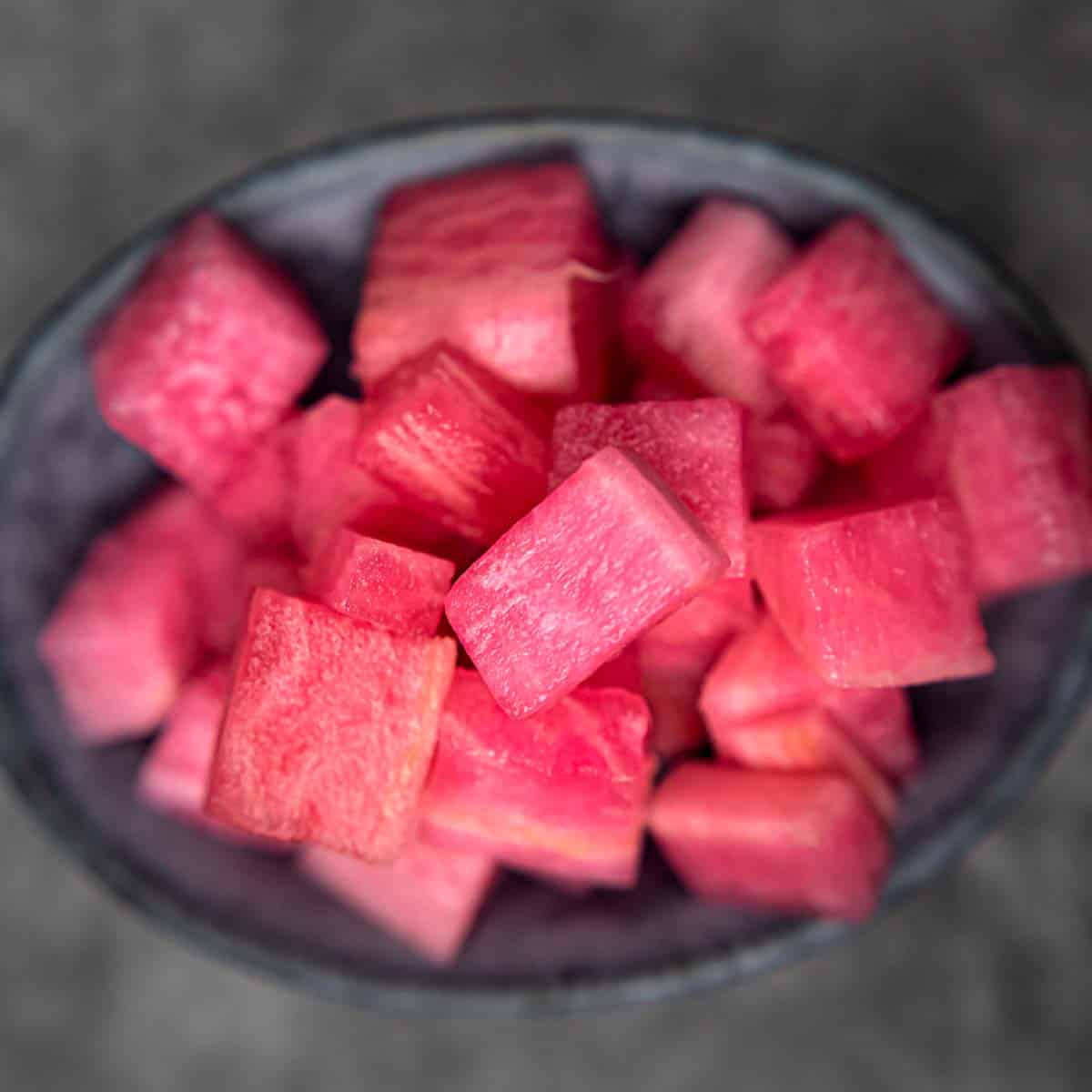
Enjoy Crunchy Korean Pickled Radish flavored with Beetroot for the best Pickled Appetizer. This Pickled Daikon goes perfectly with Korean Fried Chicken for your Ultimate Dinner Extravaganza.
Serve with sushi, naruto rolls, and chicken ramen for a delicious Asian evening.

Pickled recipes
Whether pickling or fermenting, recipes made this way are the healthiest ideas you can add to your diet.
Sauerkraut is always in my kitchen because of my love of sauerkraut soup, sauerkraut chicken, sausage and sauerkraut.
Those are all full meals. But having pickles or pickled daikon in as a side dish adds to your meal that extra tangling taste you might need.
What is Korean pickled radish?
Korean pickled radish is daikon, mu, or radish root vegetables cut into cubes or sliced into smaller pieces and pickled with white vinegar, sugar, and spices. It is a Korean side dish with kimchi and other pickled veggies.
What is Korean style radish pickles?
This Korean pickled radish recipe with beautiful light pinkish color was loved at first site. Our favorite Korean restaurant was the inspiration for this sweet and sour recipe. I love hot pot, and the restaurant always uses banchan appetizers. I could not leave it as it was and asked for a complete recipe for you.
But I am not stopping here. I have already made plain pickled daikon as well as purple daikon recipe.
To my big surprise, we went for hot pot yesterday again, and they did not serve us the usual pink pickled radish I was looking forward to, but the shredded type with some great spicy addition. Another love, I am going to prepare for you.
Is Korean pickled radish good for you?
Korean pickled radish is not only delicious and easy to make, but great for your gut. As with pickled or fermented vegetables, pickled radish is filled with calcium, vitamin C, phosphorus, magnesium, and iron.
Why do people eat pickled radishes?
In Korea, it is almost every time served with Korean fried chicken and Korean bbq to bring a perfect balance in food combination. Pickled radish is not only healthy but a very delicious Korean dish. The crunch, sweet and sour tanginess, and acidity from pickled vegetables help digest heavy fried Korean food and greatly complement the flavor of fried chicken.
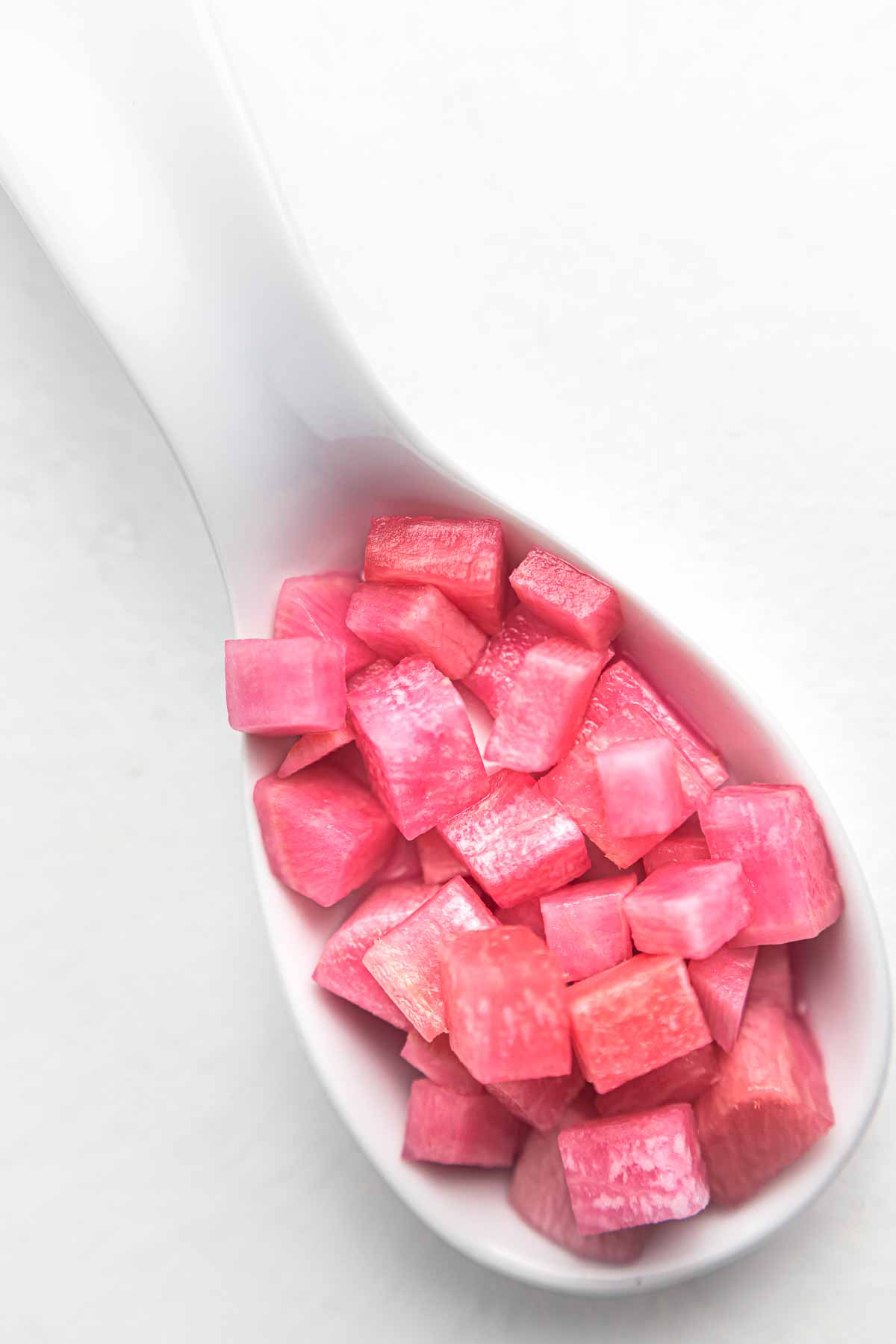
Is pickled radish keto?
Following our simple and easy recipe brings you to the most delicious keto pickled radish one can find. Sweetened with one of our approved sugar alternatives mixed with white vinegar will help keep your blood sugar levels intact.
Nutrition information is even better than one would have thought. You get only ten calories and one gram of carbs for a portion.
Can you mix carrots and daikon?
You might have seen some original recipes where daikon is mixed with carrots and shredded into a jar. This is also a possibility and by all means, do it.
The only difference with our recipe is that I have used beetroot to give them a beautiful pinkish color this time. Adding carrots, whether in squares or shredded, might color them, and I doubt it would look appetizing. I have yet to try it.
Difference between daikon and mu radish
Either daikon or radish works with our recipe. The difference is that the daikon radish is a long and skinny type of winter radish that is white in color and length. Mu radish is rounder with a slightly yellow, greenish hue on half of the outside layer and has less water content.
Both radishes are members of the cruciferous vegetable family, including cabbage, Brussels sprouts, and kale. Both vegetables are low in calories and fat and high in fiber. In our recipe, we are using Korean radish, as this is widely available in Asian grocery stores.
What does Korean pickled radish taste like?
Delicious Korean pickled radish tastes like the regular radish we are used to, with a slightly sweet and sour flavor. In addition, the tanginess with a crunchy texture makes it one of the most liked and sought side dishes to most meals. The perfect balance of sweetness and sourness makes this a great recipe.
Quick pickled Korean radish recipe
With my quick and simple recipe of combining pickling liquid flavored and colored with beetroot and mixed all together with precise cube cut radish, you will have it done in no time. The advantage of long-lasting storage allows you to serve our pink pickle with all your evening meals for that additional flavors.
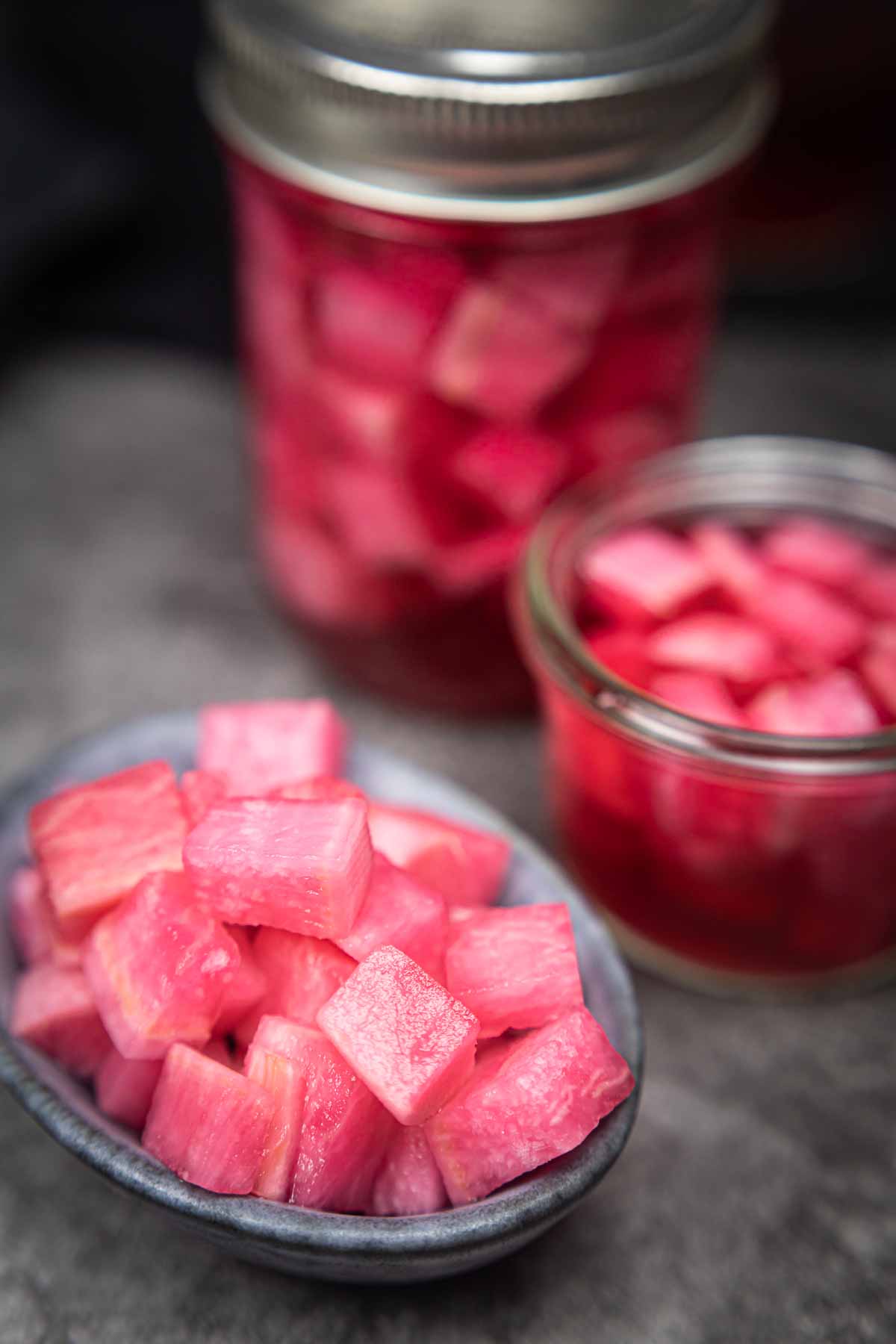
How to make Korean style pink pickled daikon radish
Kitchen gadgets needed:
- Glass jar
- Vegetable peeler
- Knife
- Mixing bowl
- Mason jars
Ingredients for Korean pickled daikon radish
- Daikon radish
- Pure beetroot juice
- Water
- Vinegar
- Sweetener
- Salt
*Exact measurements are listed in the recipe card below.
STEP-BY-STEP INSTRUCTIONS FOR A QUICK AND EASY PICKLED RADISH RECIPE
First step: Prepare ingredients
Prepare all ingredients together. The amount of beetroot juice depends on the color you want to achieve. For very light pink, use only half. I suggest using distilled white vinegar to get the best bright colors.
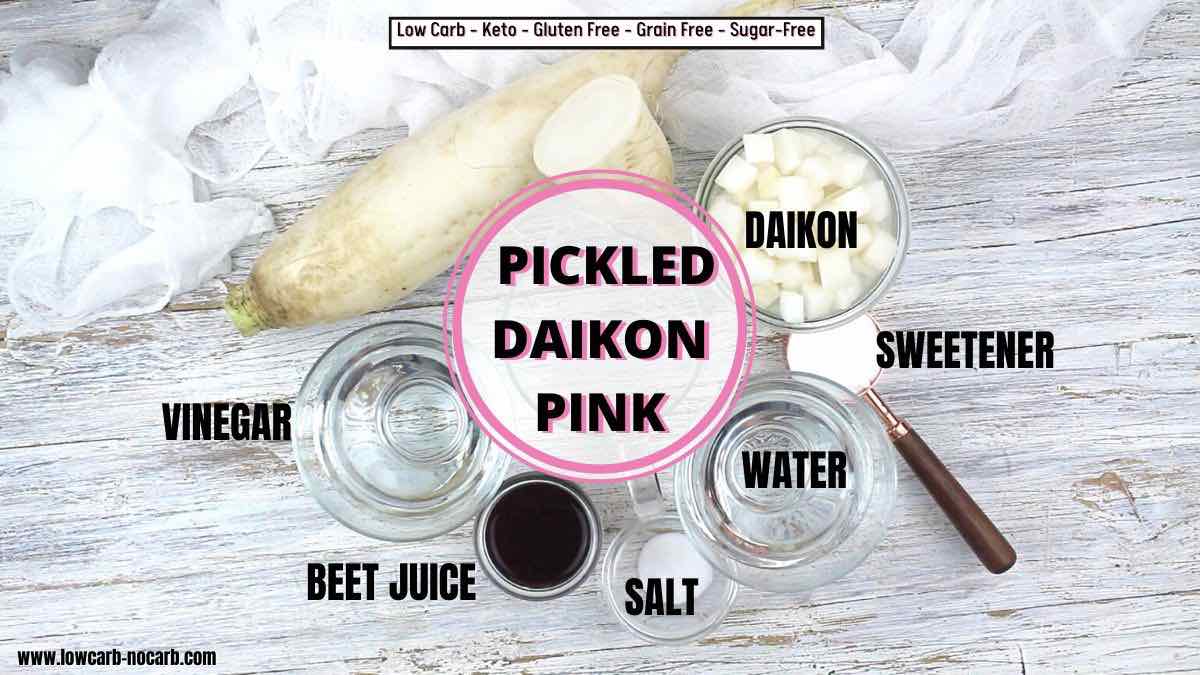
Second step: Clean and cut radish
Using a vegetable peeler, clean the outer layer of the skin of your radish. With a sharp knife, cut the radish into thick slices and then sliced radish into squares, as you see in the video.
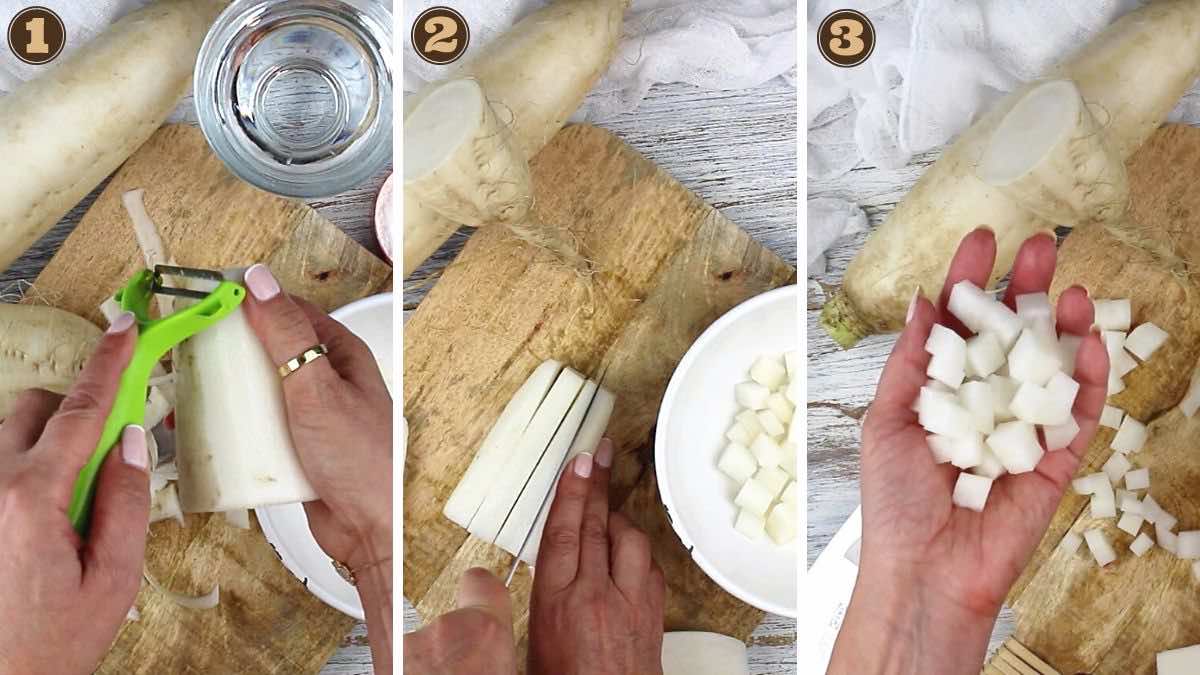
Third step: Prepare brine
To prepare your brine, you will need the same amount of water and white vinegar. Add sugar and salt to those, and use a whisk or a spoon. Mix it all until the water becomes clear again, and both salt and sweetener fully dissolve.
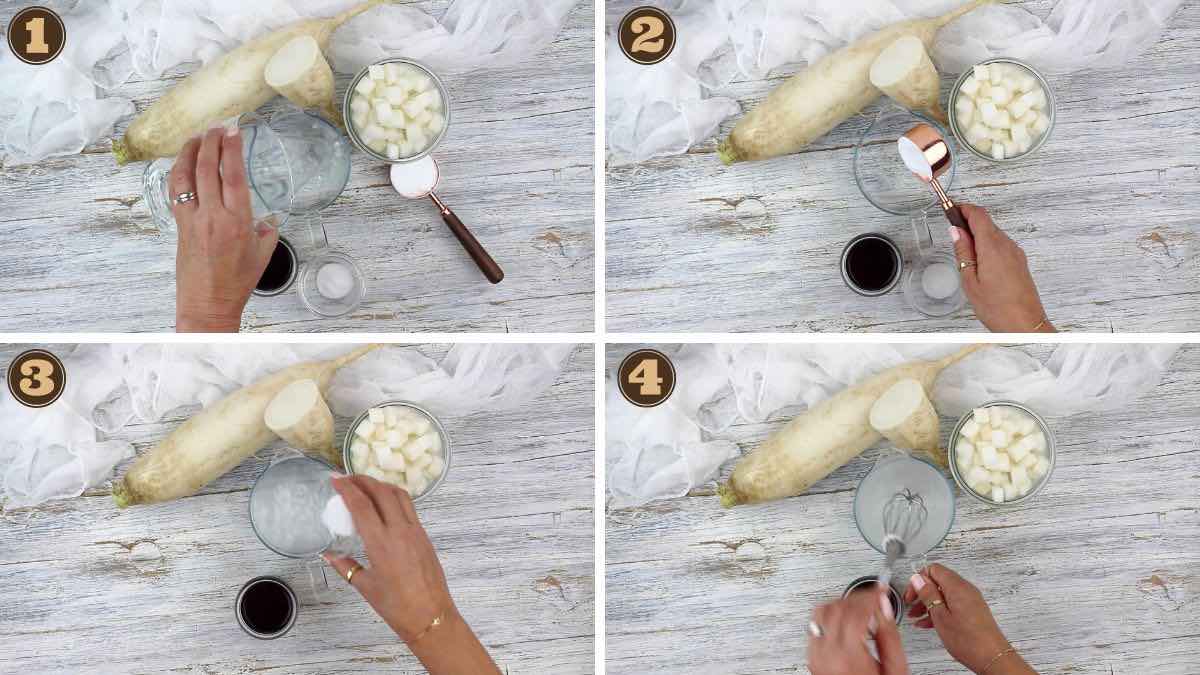
Fourth step: Flavor
Into the whole vinegar mixture, add beetroot juice. This will add a bit of sweetness and color to your radish once they are all done.
I have also tried to puree beetroot to give darker hues, but the color came the same as when you only use juice.
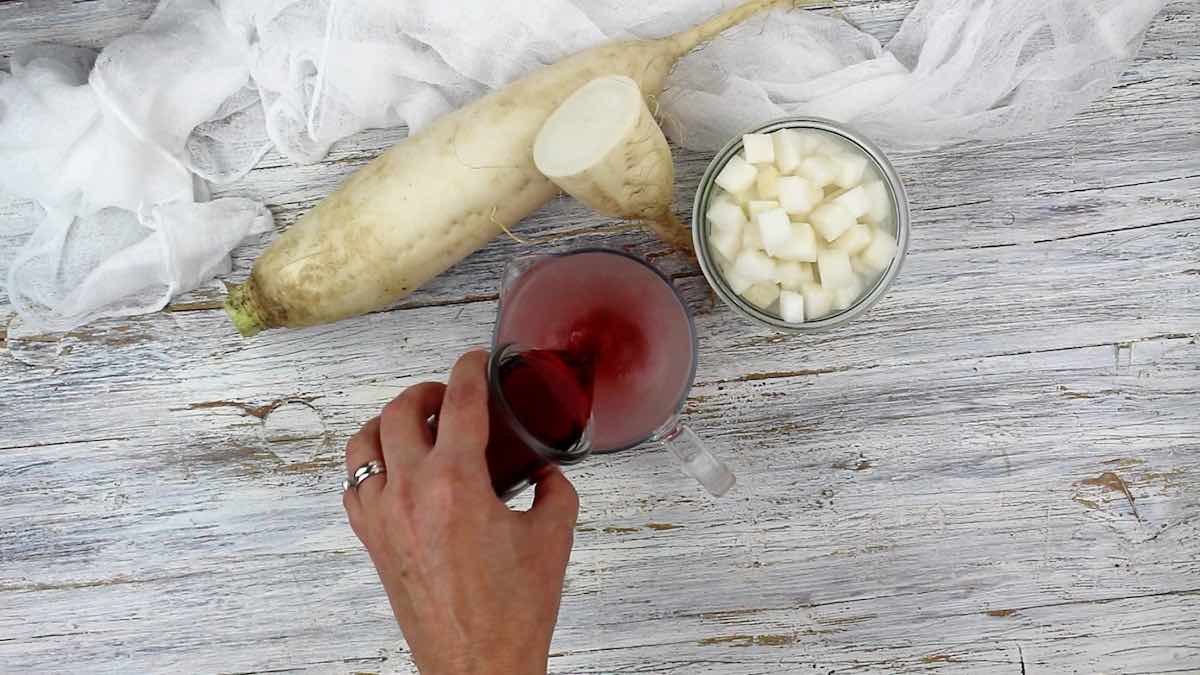
Fifth step: Fill jars
Add the radish cubes into your jars to about 3/4. Pour the vinegar mixture and close the lid. Place into the fridge and let it pickle for at least 2 to 3 days.
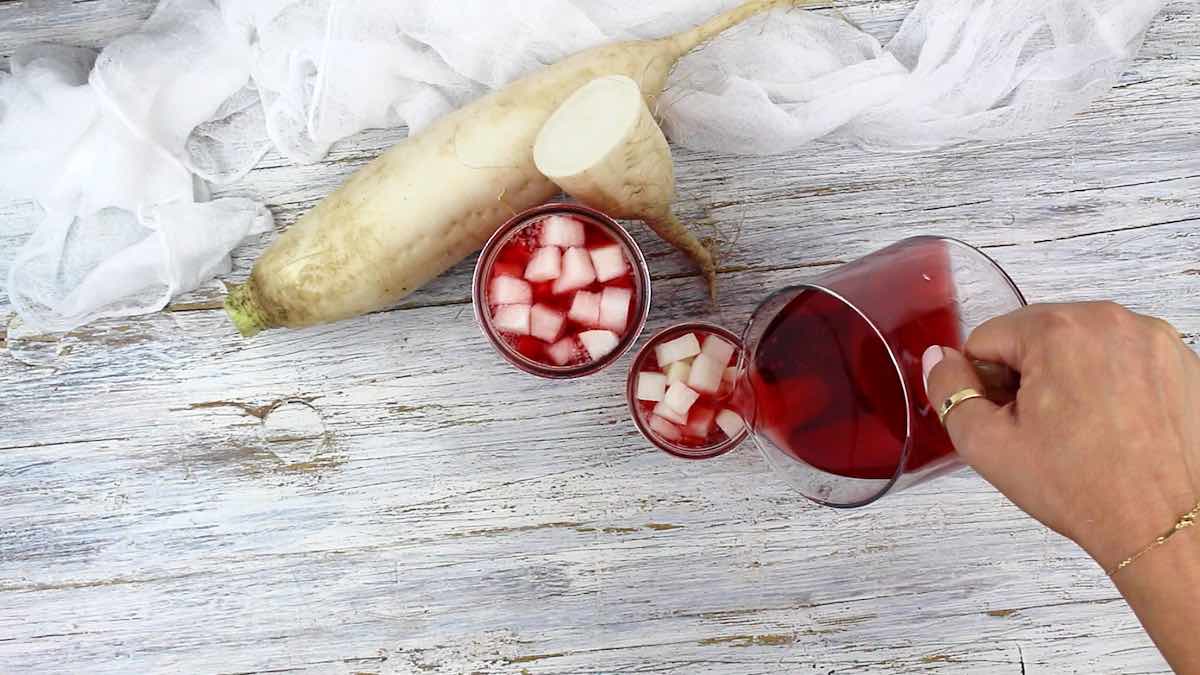
TIPS AND TRICKS:
- Vinegar – use white vinegar to achieve bright colors.
- Light pink – use only half of the beetroot juice.
- Sweetener – any sweetener such as allulose, monk fruit, or the mixture will work. I would not suggest using erythritol as it is difficult to dissolve fully.
- No beetroot – use heirloom watermelon radish, which is bright pink from the inside.
- Extra flavor – you can spice it up with red pepper flakes.
FREQUENTLY ASKED QUESTIONS AND ANSWERS
What to eat with Korean pickled radish?
Great with any type of meat dishes such as:
Can I use daikon or regular radish?
Korean daikon is perfect because it is also bright white on the inside. Some regular radishes are also red or pink on the inside. But if you do not have or do not want to use beetroot juice, you can use those or heirloom watermelon radish.
If you can’t find Korean, the heirloom watermelon radish is another Chinese variety of daikon with a dull green exterior but a bright rose or fuchsia-colored center.
Can I use other types of vinegar?
To achieve bright pink color, I suggest using white vinegar only.
But if you only have apple cider vinegar or rice vinegar, try picking the lightest. Some brands of rice wine vinegar are almost white as well.
Is this danmuji?
No. Danmuji is orange or dark yellow.
It is either prepared the same way as our recipe, but added turmeric for beautiful bright yellow-orange hue.
The traditional way of preparing danmuji or takuan is sun drying daikon for a few weeks and pickling afterward, which results in a dark yellow color.
It is very popular as a filling for kimbap, a roll from rice and nori.
But even if you buy danmuji in a Korean grocery store, you can follow our recipe. You might get a different color but have the same flavor and texture.
Can you make chicken-mu with this?
Chicken mu is pickled daikon without color, and I have the exact recipe for you.
How long do I need to pickle Korean radish?
To get the best results, after 2 to 3 days, it tastes best. But if you are in a hurry, you will realize that even after 8 hours, the taste of the radish will change, and you will feel the pickling process working. At least 1 to 2 days, please.
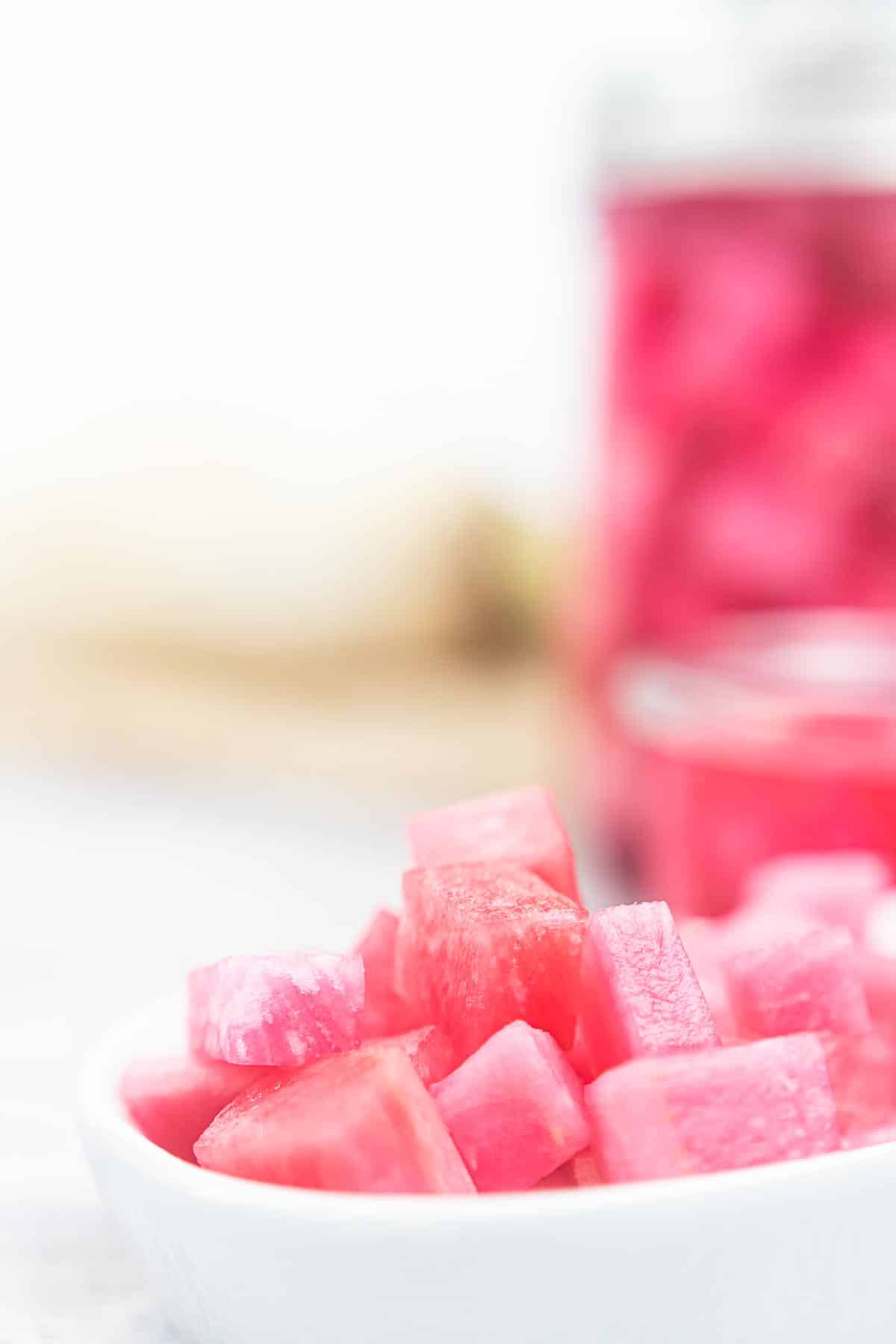
How long is Korean pickled daikon good for?
Properly stored in the fridge in an airtight container lasts for weeks to a month.
What you’d use the leftover pickle liquid for?
Like our pickles, you can use the leftover liquid to make the best keto potato salad.
How to preserve pickled daikon?
After about two days, you can preserve the jars for long-term storage. The steps and process of preserving your pickles are same as for any other preserved vegetables.
For preservation, I suggest cooking the brine in a small saucepan. Bring to a boil and cook on low heat until the sugar dissolves. Turn off the heat and let it cool to room temperature. Fill up the jars with Japanese daikon cubes and brine. Follow your favorite preservation method.
Stored in fully closed, airtight glass jars and refrigerated is best.
As they last a long time in the fridge, I do not need to freeze them.
But yes, you can freeze them without any issues. Just let them thaw naturally once ready to use.
More popular pickled vegetarian recipes
If you try this recipe, you should also look at the following:
- Pickles
- Pickled daikon
- Purple pickled daikon
- Rainbow pickled daikon radishes
Pin for later
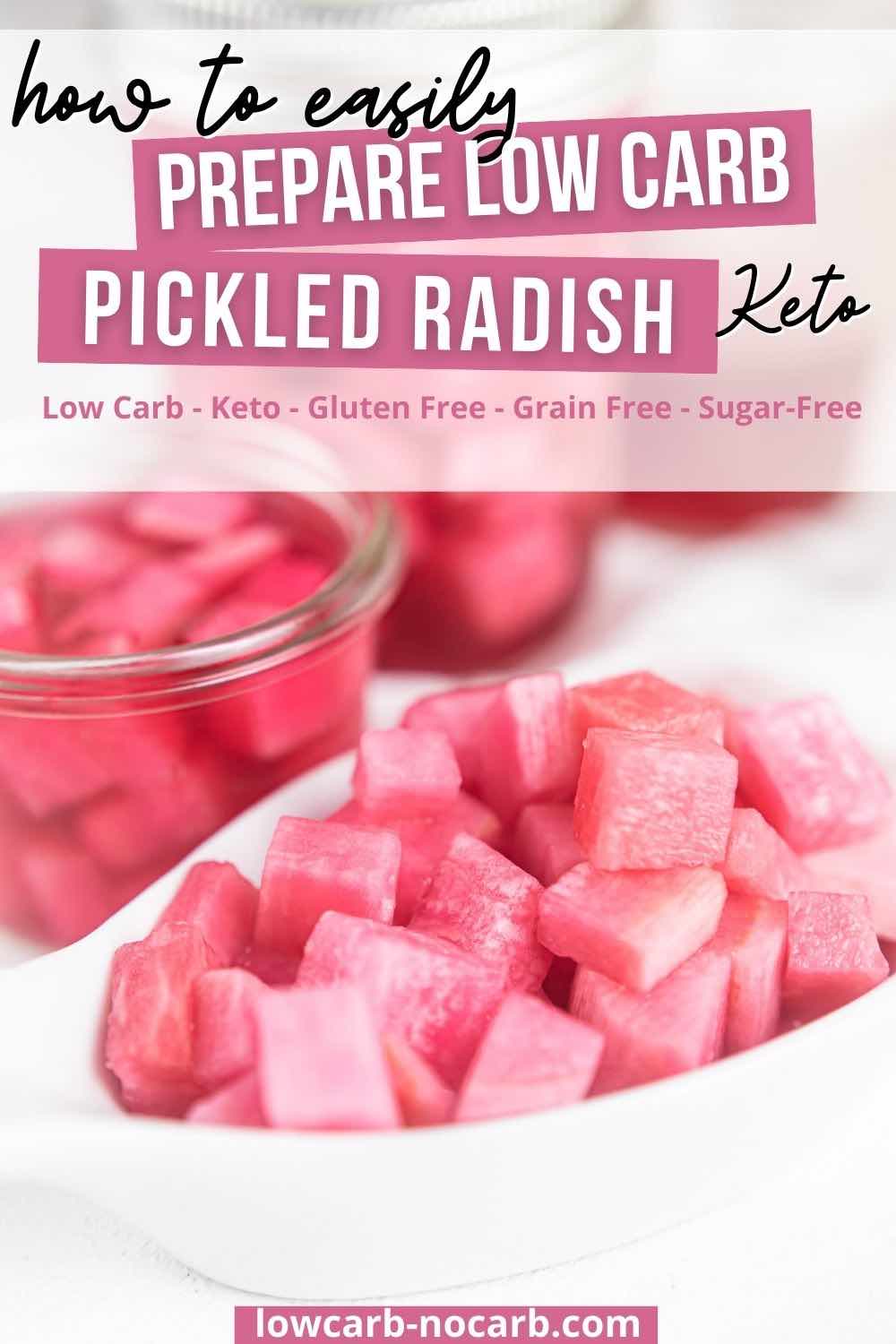
Need Support or have Questions? Join our Free Facebook Group.
Follow us on Pinterest, Facebook, Instagram, TikTok, Flipboard, or YouTube.
For weekly New Recipes and a FREE E-Book get into our NEWSLETTER.
Full Recipe with printout option
Thank you for giving us 5 stars.
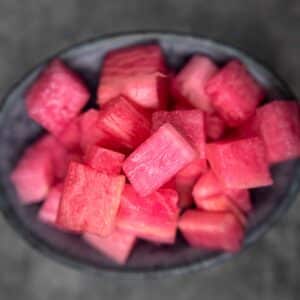
Korean Pickled Radish
Equipment
- 1 Knife
Ingredients
Instructions
- Prepare all ingredients together. The amount of beetroot juice depends on the color you want to achieve. For very light pink, use only half.
- Using a vegetable peeler, clean the outer layer of the skin of your radish. With a sharp knife, cut the radish into thick slices and then sliced radish into squares, as you see in the video.
- To prepare your brine, you will need the same amount of water and white vinegar. Add sugar and salt to those, and use a whisk or a spoon. Mix it all until the water becomes clear again, and both salt and sweetener fully dissolve.
- Into the whole vinegar mixture, add beetroot juice. This will add a bit of sweetness and color to your radish once they are all done.
- Add the radish cubes into your jars to about 3/4. Pour the vinegar mixture and close the lid. Place into the fridge and let it pickle for at least 2 to 3 days.
Video
Notes
- Vinegar – use white vinegar to achieve bright colors.
- Light pink – use only half of the beetroot juice.
- Sweetener – any sweetener such as allulose, monk fruit, or the mixture will work. I would not suggest using erythritol as it is difficult to dissolve fully.
- No beetroot – use heirloom watermelon radish, which is bright pink from the inside.
- Extra flavor – you can spice it up with red pepper flakes.
Nutrition
Disclaimer
Please note that nutrient values are estimates only. Variations can occur due to product availability and manner of food preparation. Nutrition may vary based on methods of origin, preparation, freshness of ingredients, and other factors.
If you are still looking for some Low Carb products, visit our recommended site on Amazon, which we participate in as affiliates. Just click on the image below and all will be revealed.


